AmirAli Abdolrashidi
Pareto-Optimal Quantized ResNet Is Mostly 4-bit
May 07, 2021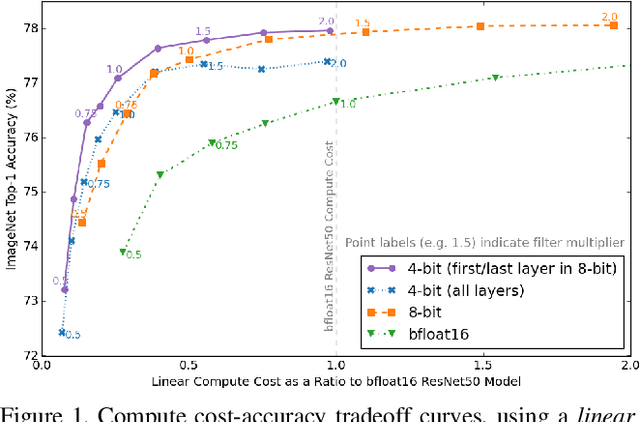


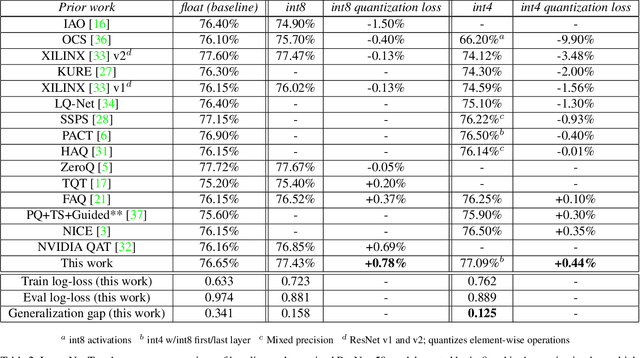
Abstract:Quantization has become a popular technique to compress neural networks and reduce compute cost, but most prior work focuses on studying quantization without changing the network size. Many real-world applications of neural networks have compute cost and memory budgets, which can be traded off with model quality by changing the number of parameters. In this work, we use ResNet as a case study to systematically investigate the effects of quantization on inference compute cost-quality tradeoff curves. Our results suggest that for each bfloat16 ResNet model, there are quantized models with lower cost and higher accuracy; in other words, the bfloat16 compute cost-quality tradeoff curve is Pareto-dominated by the 4-bit and 8-bit curves, with models primarily quantized to 4-bit yielding the best Pareto curve. Furthermore, we achieve state-of-the-art results on ImageNet for 4-bit ResNet-50 with quantization-aware training, obtaining a top-1 eval accuracy of 77.09%. We demonstrate the regularizing effect of quantization by measuring the generalization gap. The quantization method we used is optimized for practicality: It requires little tuning and is designed with hardware capabilities in mind. Our work motivates further research into optimal numeric formats for quantization, as well as the development of machine learning accelerators supporting these formats. As part of this work, we contribute a quantization library written in JAX, which is open-sourced at https://github.com/google-research/google-research/tree/master/aqt.
Deep-Sentiment: Sentiment Analysis Using Ensemble of CNN and Bi-LSTM Models
Apr 08, 2019


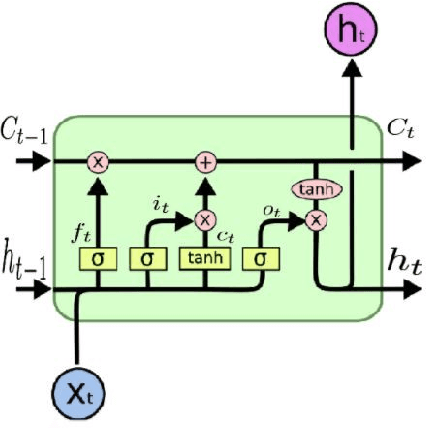
Abstract:With the popularity of social networks, and e-commerce websites, sentiment analysis has become a more active area of research in the past few years. On a high level, sentiment analysis tries to understand the public opinion about a specific product or topic, or trends from reviews or tweets. Sentiment analysis plays an important role in better understanding customer/user opinion, and also extracting social/political trends. There has been a lot of previous works for sentiment analysis, some based on hand-engineering relevant textual features, and others based on different neural network architectures. In this work, we present a model based on an ensemble of long-short-term-memory (LSTM), and convolutional neural network (CNN), one to capture the temporal information of the data, and the other one to extract the local structure thereof. Through experimental results, we show that using this ensemble model we can outperform both individual models. We are also able to achieve a very high accuracy rate compared to the previous works.
On The Power of Joint Wavelet-DCT Features for Multispectral Palmprint Recognition
Nov 26, 2015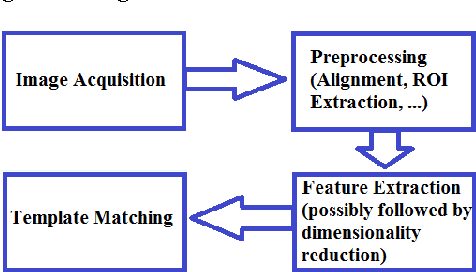


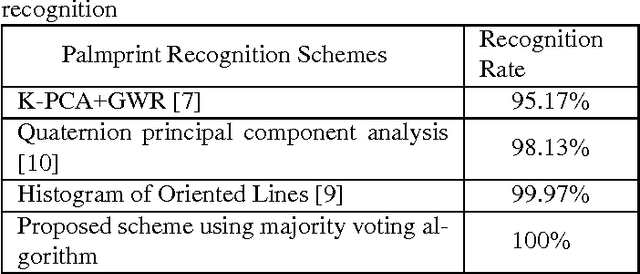
Abstract:Biometric-based identification has drawn a lot of attention in the recent years. Among all biometrics, palmprint is known to possess a rich set of features. In this paper we have proposed to use DCT-based features in parallel with wavelet-based ones for palmprint identification. PCA is applied to the features to reduce their dimensionality and the majority voting algorithm is used to perform classification. The features introduced here result in a near-perfectly accurate identification. This method is tested on a well-known multispectral palmprint database and an accuracy rate of 99.97-100\% is achieved, outperforming all previous methods in similar conditions.
Iris Recognition Using Scattering Transform and Textural Features
Jul 08, 2015
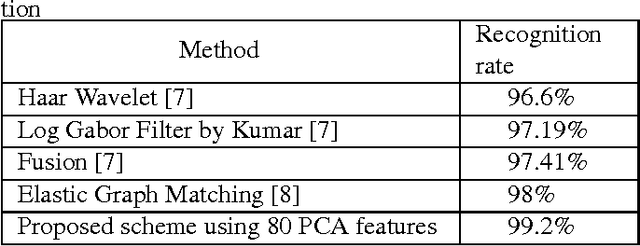


Abstract:Iris recognition has drawn a lot of attention since the mid-twentieth century. Among all biometric features, iris is known to possess a rich set of features. Different features have been used to perform iris recognition in the past. In this paper, two powerful sets of features are introduced to be used for iris recognition: scattering transform-based features and textural features. PCA is also applied on the extracted features to reduce the dimensionality of the feature vector while preserving most of the information of its initial value. Minimum distance classifier is used to perform template matching for each new test sample. The proposed scheme is tested on a well-known iris database, and showed promising results with the best accuracy rate of 99.2%.
Highly Accurate Multispectral Palmprint Recognition Using Statistical and Wavelet Features
Jun 24, 2015
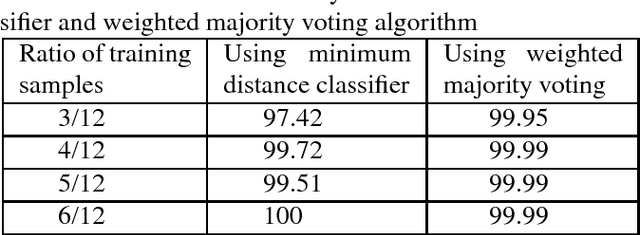
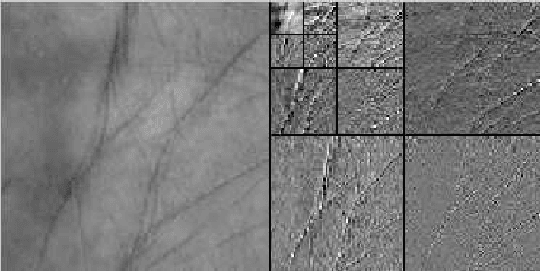
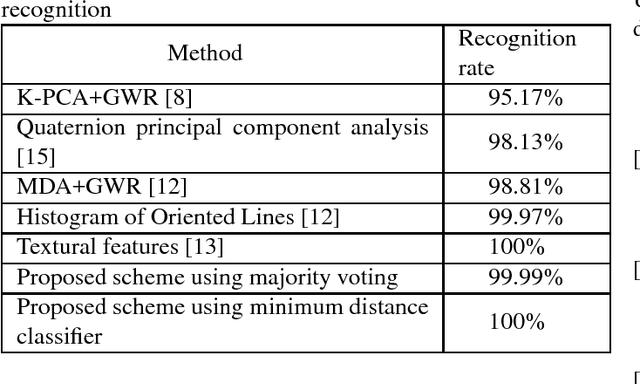
Abstract:Palmprint is one of the most useful physiological biometrics that can be used as a powerful means in personal recognition systems. The major features of the palmprints are palm lines, wrinkles and ridges, and many approaches use them in different ways towards solving the palmprint recognition problem. Here we have proposed to use a set of statistical and wavelet-based features; statistical to capture the general characteristics of palmprints; and wavelet-based to find those information not evident in the spatial domain. Also we use two different classification approaches, minimum distance classifier scheme and weighted majority voting algorithm, to perform palmprint matching. The proposed method is tested on a well-known palmprint dataset of 6000 samples and has shown an impressive accuracy rate of 99.65\%-100\% for most scenarios.
Multispectral Palmprint Recognition Using Textural Features
Feb 12, 2015


Abstract:In order to utilize identification to the best extent, we need robust and fast algorithms and systems to process the data. Having palmprint as a reliable and unique characteristic of every person, we extract and use its features based on its geometry, lines and angles. There are countless ways to define measures for the recognition task. To analyze a new point of view, we extracted textural features and used them for palmprint recognition. Co-occurrence matrix can be used for textural feature extraction. As classifiers, we have used the minimum distance classifier (MDC) and the weighted majority voting system (WMV). The proposed method is tested on a well-known multispectral palmprint dataset of 6000 samples and an accuracy rate of 99.96-100% is obtained for most scenarios which outperforms all previous works in multispectral palmprint recognition.
 Add to Chrome
Add to Chrome Add to Firefox
Add to Firefox Add to Edge
Add to Edge